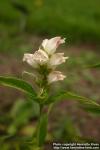Chelone.—Balmony.

 The herb, and especially the leaves of Chelone glabra, Linné.
The herb, and especially the leaves of Chelone glabra, Linné.
Nat. Ord.—Scrophulariaceae.
COMMON NAMES: Balmony, Snakehead, Turtlehead, Turtlebloom, Shellflower, Salt-rheum weed.
Botanical Source.—This is a perennial, smooth, herbaceous plant, with a simple, erect, somewhat 4-sided stem, about 2 or 3 feet high. The leaves are opposite, sessile, or nearly so, smooth, oblong-lanceolate, acuminate, serrate, and of a dark, shining green above. The flowers are large, inodorous, white, rose color, or purple, subsessile, in a short, terminal, dense spike, somewhat resembling the head of a snake or tortoise; the corolla is inflated, bilabiate, and contracted at the mouth; the upper lip is broad and arched, and keeled in the middle; the one woolly within; the calyx is deeply 5-parted, with 3 bracts at the base. Stamens 4, with hairy filaments and hairy, cordate anthers, a fifth sterile filament smaller than the others; ovary ovate; style long, exsert, and bending downward. The fruit is an oval, 2-celled 2-valved capsule, with many small, wing-margined seeds (W.—G.).
History.—This valuable medicinal plant is in the United States in damp soils, flowering in August and September. The flowers are very ornamental, and vary in color, according to the variety of the there being many varieties. The leaves are exceedingly bitter, but inodorous, and communicate their properties to both water and alcohol.
Chemical Composition.—W. Pfeuffer (1892, who made an approximate analysis of the over-ground portion of this herb, detected in the alcoholic and ethereal extracts, a glucosid, which, when decomposed, evolved a peculiar, disagreeable odor. The usual plant constituents were found, and from the ethereal extract crystals giving the reactions for gallic acid were obtained (A. P. A. Proc., 1892).
Action, Medical Uses, and Dosage.—Tonic, cathartic, and anthelmintic. Especially valuable in jaundice and hepatic diseases, likewise for the removal of worms, for which it may be used in powder or decoction, internally and also in injection. Used as a tonic in small doses, in dyspepsia, debility of the digestive organs, particularly when associated with hepatic inactivity, and during convalescence from febrile and inflammatory diseases. It is valuable after malarial fevers as a tonic and to unlock the secretions when checked by quinine. Recommended in form of ointment as an application to painful and inflamed tumors, irritable and painful ulcers, inflamed breasts, piles, etc. Dose of the powder, 1 drachm; of the tincture, 1 or 2 fluid drachms; of the decoction, 1 or 2 fluid ounces; specific chelone, 10 to 30 drops.
Specific Indications and Uses.—Gastro-intestinal debility, with hepatic torpor or jaundice; worms.

